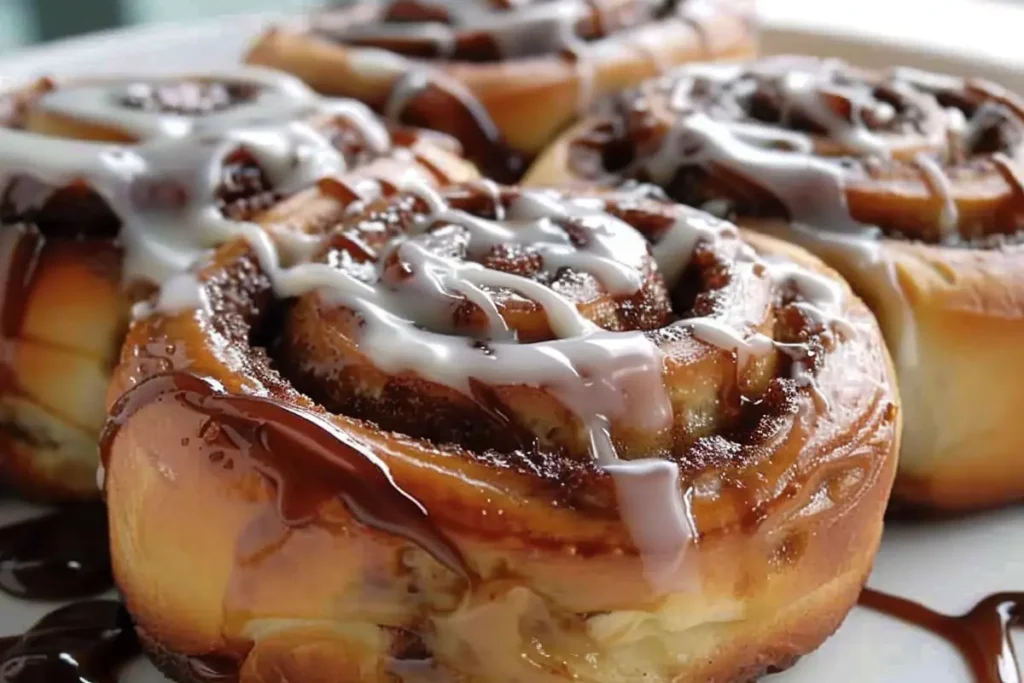Table of Contents: Difference Between Cinnamon Bun and Cinnamon Roll
Introduction: Difference Between Cinnamon Bun and Cinnamon Roll
Is there anything more comforting than the warm aroma of cinnamon wafting through your kitchen on a lazy weekend morning? For many, the debate of Cinnamon Bun vs. Cinnamon Roll is more than just semantics—it’s a flavor-packed journey through texture, topping, and tradition. Whether you’re team bun or team roll, you’re in for a treat (literally).
Today, we’re diving deep into the difference between cinnamon bun and cinnamon roll, and we’re not just talking frosting here. I’ll even throw in a beloved cinnamon bun recipe that’s been in my family for generations!
What is a Cinnamon Roll?
Let’s start with the classic: the cinnamon roll. A beloved staple in American bakeries, especially across the Midwest and Southern states, cinnamon rolls are known for their soft, spiral shape, buttery cinnamon-sugar filling, and, of course, that luscious, sweet icing drizzled on top.
Key Characteristics:
- Shape: Rolled spiral
- Filling: Cinnamon, brown sugar, sometimes butter
- Topping: Typically glazed with icing or cream cheese frosting
- Texture: Soft, fluffy, often slightly gooey
- Serving Style: Pulled apart or sliced into spirals
What is a Cinnamon Bun?

Now, onto its close cousin: the cinnamon bun. While the ingredients might sound similar, cinnamon buns have their own signature twist—literally and figuratively.
Key Characteristics:
- Shape: Twisted or coiled (less uniform than a roll)
- Filling: Cinnamon and sugar, sometimes with nuts or raisins
- Topping: Often baked with a sticky caramel glaze and nuts
- Texture: Denser and stickier than rolls
- Serving Style: Pulled from a tray or individually baked
So, What’s the Real Difference Between Cinnamon Bun and Cinnamon Roll?
Let’s break it down side-by-side to get a clearer picture:
| Feature | Cinnamon Roll | Cinnamon Bun |
|---|---|---|
| Dough | Soft, fluffy, often enriched with eggs | Slightly denser, chewier |
| Shape | Rolled in spirals | Twisted, coiled, or bun-like |
| Topping | Icing or frosting | Sticky glaze, often with nuts |
| Filling | Cinnamon + sugar | Cinnamon, sugar, sometimes nuts or raisins |
| Baking Style | Baked individually or in a pan | Often baked together in a sticky tray |
| Texture | Gooey and soft | Sticky, caramelized edges |
The Origins of These Sweet Treats
Both cinnamon buns and rolls trace their origins to Northern Europe. Cinnamon rolls, or kanelbullar, are a staple in Sweden, celebrated on Kanelbullens dag (Cinnamon Roll Day) every October 4th. Meanwhile, sticky buns (the Americanized cinnamon bun) have a strong presence in Pennsylvania Dutch cuisine, with a legacy tied to German immigrants.
So while both pastries share roots, the American versions have taken on distinct identities based on regional preferences and baking styles.
When to Serve Each (and Why It Matters!)
- Cinnamon Rolls are your go-to brunch stars. Think Sunday family breakfasts, Mother’s Day, or holiday mornings.
- Cinnamon Buns are perfect for dessert trays, potlucks, or anytime you want something indulgent and sticky.
Pro tip: If you love finger-licking treats, cinnamon buns are your jam. If you like clean slices with frosting on top, cinnamon rolls are your hero.
Which One is Healthier?
Neither, let’s be honest. But we love them anyway!
That said, cinnamon rolls are generally lighter (due to less glaze and nuts), while cinnamon buns pack more sugar and fat thanks to the sticky caramel topping.
A Recipe from My Nonna’s Kitchen: Old-Fashioned Cinnamon Buns

Now that you know the difference between cinnamon bun and cinnamon roll, let’s get baking! This cinnamon bun recipe is inspired by my Italian grandmother who adored anything sweet with her espresso.
🍴 Ingredients (Makes 12 Buns)
For the Dough:
- 1 cup warm milk (110°F)
- 2 ¼ tsp active dry yeast
- ½ cup granulated sugar
- 2 large eggs
- 6 tbsp unsalted butter, melted
- 4 cups all-purpose flour
- 1 tsp salt
For the Filling:
- ¾ cup brown sugar
- 2 tbsp ground cinnamon
- 6 tbsp butter, softened
For the Sticky Glaze:
- ½ cup brown sugar
- ¼ cup unsalted butter
- ¼ cup honey or maple syrup
- 1 cup chopped pecans (optional)
🧁 Instructions
- Activate Yeast: In a bowl, combine warm milk and yeast. Let sit for 5 minutes until frothy.
- Make Dough: Add sugar, eggs, melted butter, and salt. Slowly mix in flour until a soft dough forms.
- Knead & Rise: Knead for 8 minutes, then cover and let rise for 1–1.5 hours until doubled.
- Prepare Filling: Mix brown sugar and cinnamon. Roll out dough into a rectangle, spread with softened butter, and sprinkle cinnamon sugar.
- Roll & Slice: Roll tightly and cut into 12 even buns.
- Make Sticky Glaze: In a saucepan, melt butter with brown sugar and honey. Pour into baking pan, sprinkle nuts if using.
- Bake: Place buns on top of glaze and bake at 350°F (175°C) for 25–30 minutes until golden.
- Cool & Flip: Let rest 5 minutes, then invert onto a tray to reveal that gooey caramel top.
FAQs: Difference Between Cinnamon Bun and Cinnamon Roll
1. What is the main difference between a cinnamon bun and a cinnamon roll?
The biggest difference between cinnamon bun and cinnamon roll lies in their toppings and texture. Cinnamon buns are typically baked with a sticky caramel glaze and often include nuts, while cinnamon rolls are known for their soft spiral shape and creamy icing or frosting on top.
2. Are cinnamon buns sweeter than cinnamon rolls?
Yes, cinnamon buns tend to be sweeter and stickier due to the caramelized glaze and sometimes added nuts. Cinnamon rolls, while sweet, are usually lighter with a fluffy texture and frosted top.
3. Can I use the same dough for both cinnamon buns and cinnamon rolls?
Absolutely! The dough is often similar. The magic is in how you shape, fill, and top them. For buns, go sticky and caramelized; for rolls, keep it soft and icing-topped.
4. Which is more traditional in the United States?
Cinnamon rolls are more commonly found in bakeries and cafés across the U.S., especially with that iconic swirl and icing. However, sticky buns (a type of cinnamon bun) have deep roots in Pennsylvania Dutch country.
5. Can I turn this cinnamon bun recipe into cinnamon rolls instead?
Yes! Skip the sticky glaze and nuts. After shaping and baking the rolls, top them with a cream cheese frosting or vanilla glaze instead.
6. Are cinnamon buns and cinnamon rolls healthy?
While both are indulgent treats, cinnamon rolls may be a slightly lighter option compared to buns which contain extra sugar and fat from the glaze and nuts. Always enjoy them in moderation—life’s about balance, after all!
Final Thoughts
Whether you’re into the frosted elegance of cinnamon rolls or the sticky indulgence of cinnamon buns, one thing’s for sure—both make your day sweeter. Now that you know the difference between cinnamon bun and cinnamon roll, why not try both and pick your favorite?
More Recipes To Discover
- How to Make Swedish Cinnamon Buns
- America’s Test Kitchen Cinnamon Rolls
- History of Sticky Buns
- Cinnamon Bun Day in Sweden

Difference Between Cinnamon Bun and Cinnamon Roll
- Total Time: 2 hours 25 minutes (includes Rest time)
- Yield: 12 buns 1x
- Diet: Vegetarian
Description
Soft, sticky, and packed with cinnamon sugar flavor, these homemade cinnamon buns are baked with a rich caramel glaze and crunchy pecans. Perfect for breakfast or dessert!
Ingredients
For the Dough:
1 cup warm milk (110°F)
2 ¼ tsp active dry yeast
½ cup granulated sugar
2 large eggs
6 tbsp unsalted butter, melted
4 cups all-purpose flour
1 tsp salt
For the Filling:
¾ cup brown sugar
2 tbsp ground cinnamon
6 tbsp butter, softened
For the Sticky Glaze:
½ cup brown sugar
¼ cup unsalted butter
¼ cup honey or maple syrup
1 cup chopped pecans (optional)
Instructions
-
In a bowl, combine warm milk and yeast. Let sit for 5 minutes until frothy.
-
Mix in sugar, eggs, melted butter, and salt. Slowly stir in flour until a soft dough forms.
-
Knead for 8 minutes, then cover and let rise 1–1.5 hours until doubled in size.
-
Roll dough into a large rectangle. Spread softened butter over it. Sprinkle with brown sugar and cinnamon.
-
Roll up tightly and cut into 12 buns.
-
In a saucepan, melt glaze ingredients. Pour into a baking pan and sprinkle with pecans.
-
Arrange buns on top of glaze. Cover and let rise 30 minutes.
-
Bake at 350°F (175°C) for 25–30 minutes until golden brown.
-
Cool 5 minutes, then flip onto a tray so the sticky bottom becomes the top. Enjoy!
Notes
-
You can substitute maple syrup for honey in the glaze.
-
These freeze well—wrap tightly and thaw before reheating.
-
For extra gooey buns, use more glaze and bake closer together.
- Prep Time: 25 minutes
- Cook Time: 30 minutes
- Category: Breakfast, Dessert
- Method: Baking
- Cuisine: American
Nutrition
- Serving Size: 1 bun
- Calories: 380
- Sugar: 24g
- Sodium: 180mg
- Fat: 16g
- Saturated Fat: 8g
- Unsaturated Fat: 6g
- Trans Fat: 0g
- Carbohydrates: 52g
- Fiber: 2g
- Protein: 6g
- Cholesterol: 60mg
Keywords: cinnamon bun, sticky bun, homemade cinnamon rolls, caramel buns

